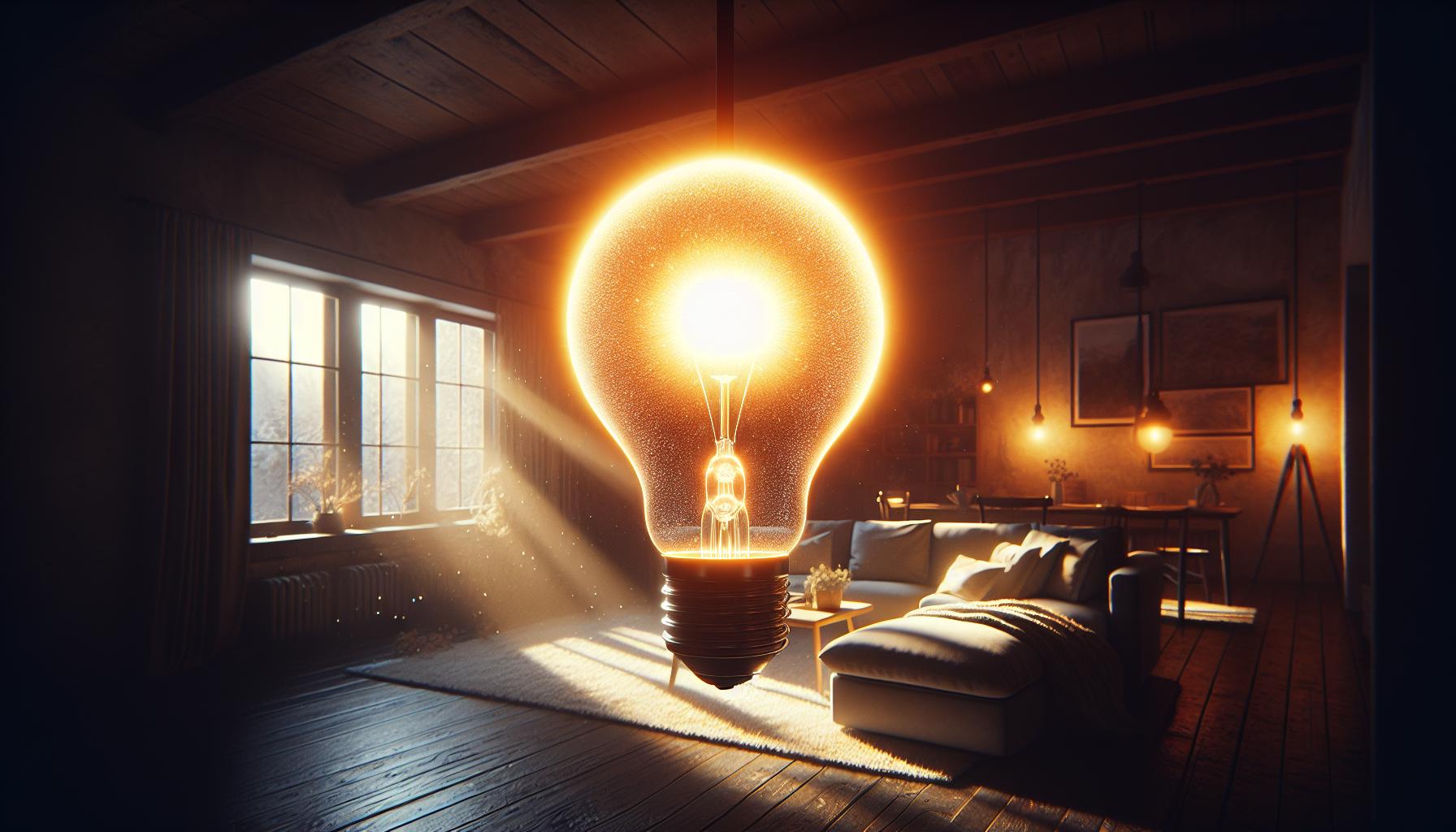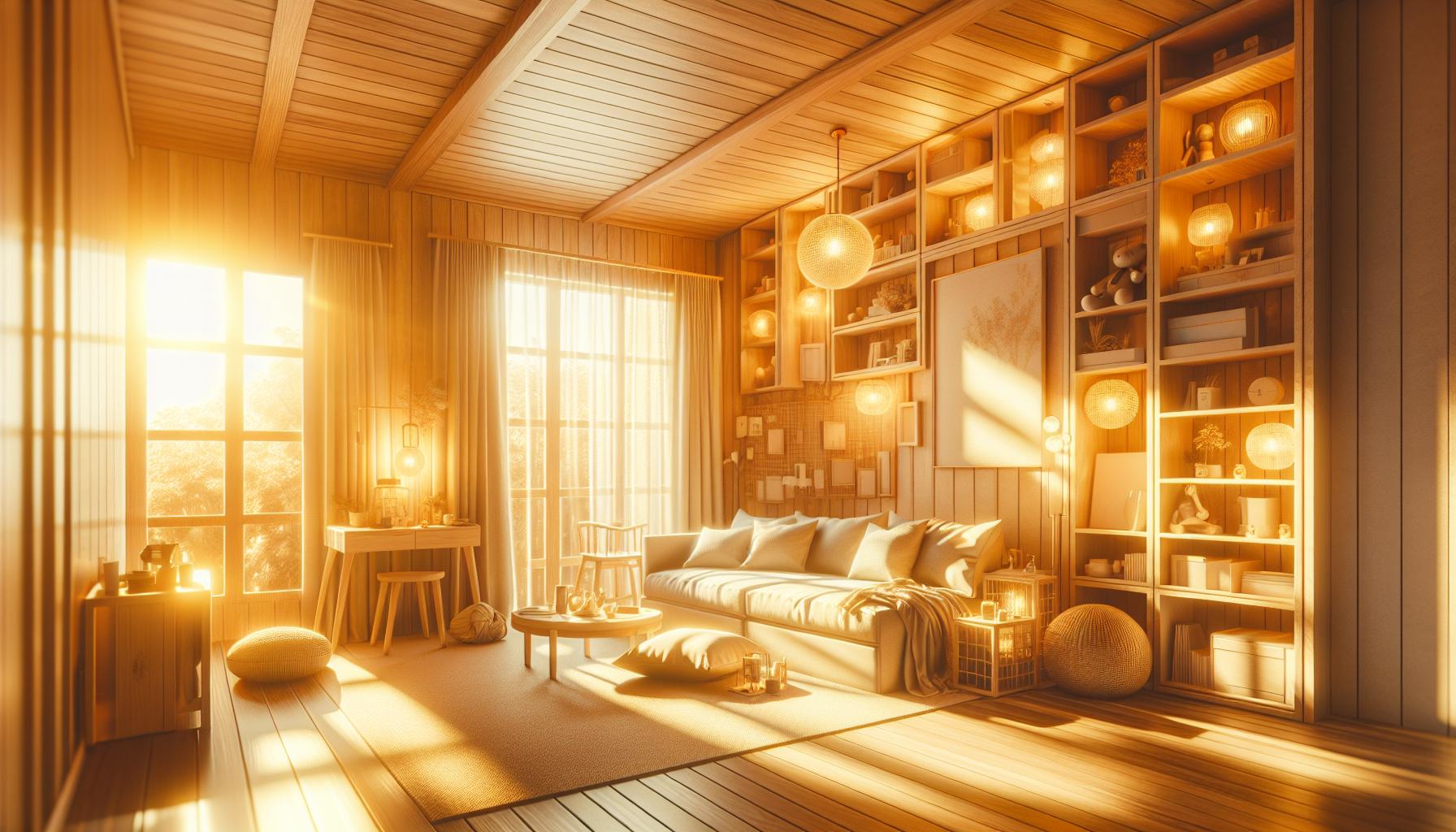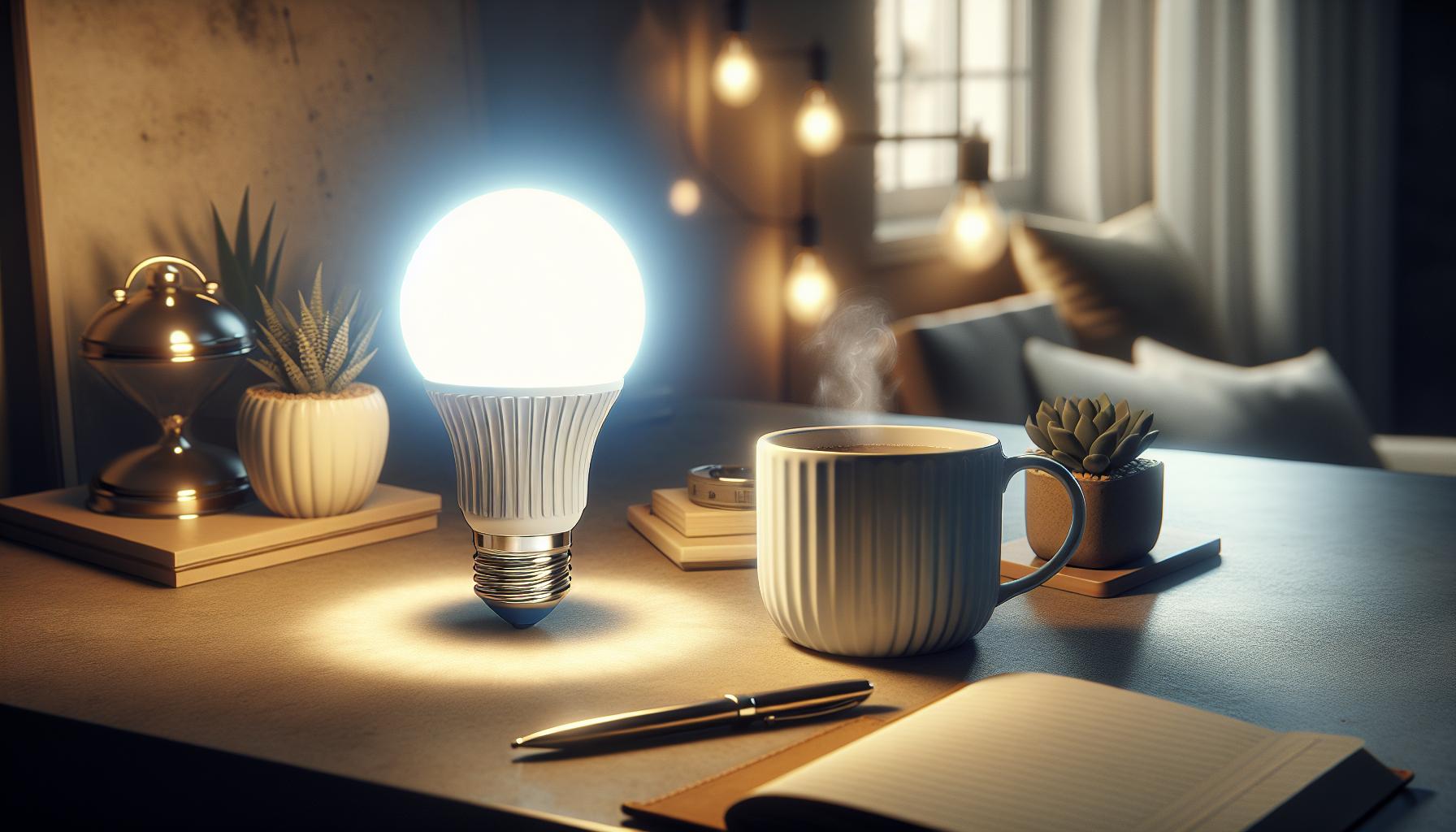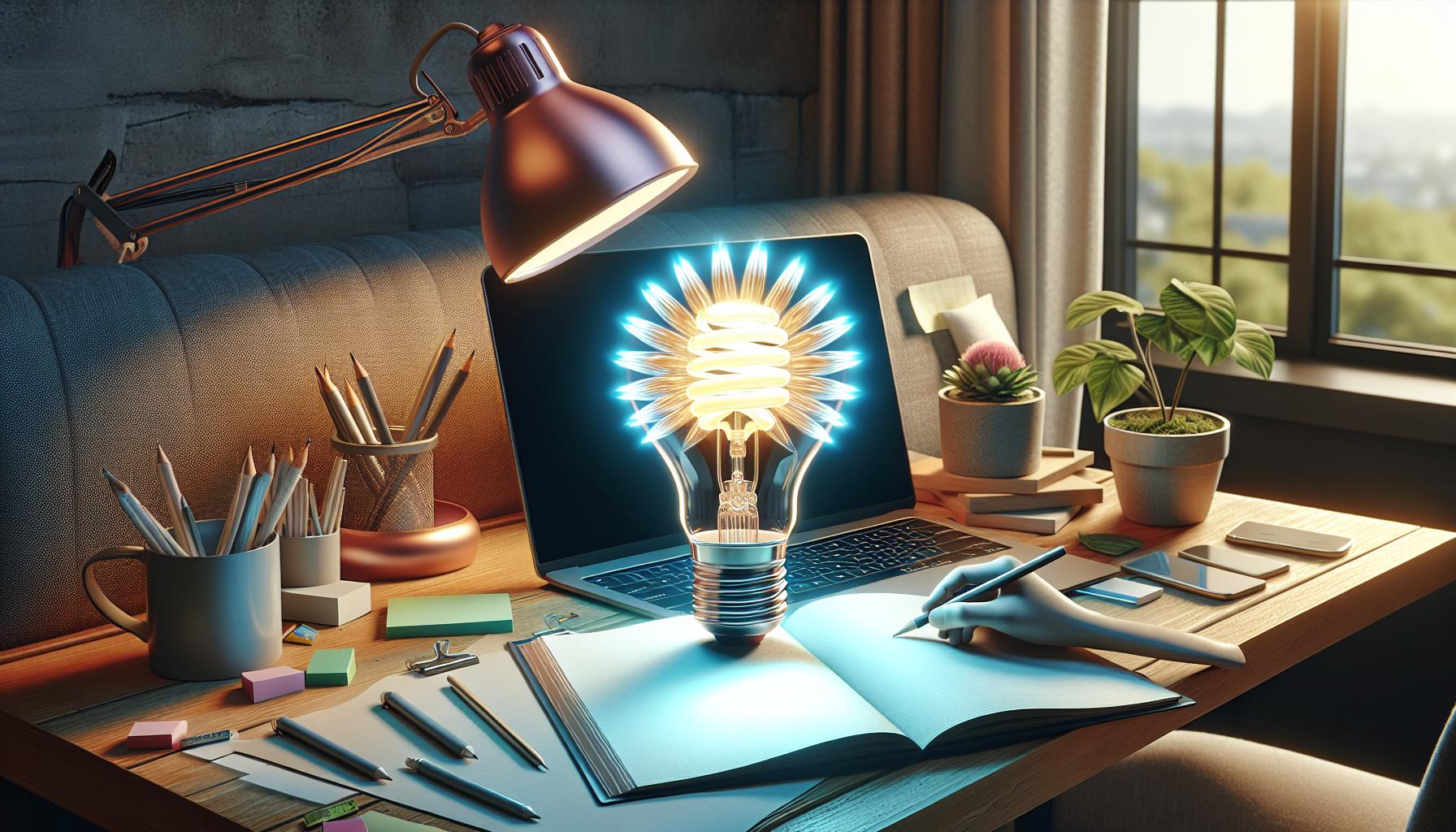Ever felt down during the long, dark winter months? You’re not alone. Seasonal Affective Disorder, or SAD, can really take a toll on your mood. But what if you could light up your life with a simple bulb?

Enter SAD light bulbs, a beacon of hope for those dreary days. They’re designed to mimic natural sunlight, potentially lifting your spirits when you need it most. Curious? Let’s dive into the bright world of SAD light bulbs and see if they can shine some light on your winter blues.
What is Seasonal Affective Disorder (SAD)?
Imagine feeling a sudden shift in your mood as the seasons change. You’re not alone in this; many people experience a type of depression that comes and goes with the seasons, most commonly starting in late fall and early winter. That’s Seasonal Affective Disorder (SAD) for you—it’s more than just the “winter blues.” Symptoms include low energy, sleeping issues, changes in appetite or weight, and feeling sluggish or agitated.
For all you home DIY enthusiasts and light savants, understanding SAD is crucial because the right lighting can transform your home and your mood. SAD is believed to be influenced by the changing patterns of light and darkness that occur with the changing seasons. It’s as if your body’s internal clock, which dictates your sleep-wake cycle, goes haywire when the daylight diminishes, disrupting your natural rhythms.
How Does Light Affect SAD?
As an expert in lighting, you’re likely aware that light has profound effects on well-being. With SAD, the lack of sunlight can lead to a drop in serotonin, a brain chemical that affects mood, and can increase the level of melatonin, which can make you sleepy. Here’s where the transformative power of light comes into play:
- Artificial lighting, particularly SAD light bulbs, are designed to mimic the natural sunlight that’s missing during the darker months.
- Exposure to this light can cause a chemical change in the brain that lifts your mood and eases other SAD symptoms.
- Correct usage of SAD light bulbs can help regulate your circadian rhythm, effectively telling your internal clock it’s time to be awake and alert.
It’s absolutely fascinating how making small alterations in your home lighting can significantly impact your daily life. Although additional sunlight might be sparse in those chilly winter months, with knowledge and the right tools, you can reclaim your comfort and maintain a brighter disposition.
Understanding the Impact of SAD
When winter strikes, the days get shorter, and darkness prevails. You’re a home DIY lover and light aficionado, and you understand the profound effect lighting has on mood and wellbeing. That’s why grasping the full impact of Seasonal Affective Disorder, or SAD, is crucial for you.
SAD isn’t just an emotional response to the lack of festive cheer; it’s a clinical condition influenced by dwindling daylight hours. This scarcity of sunlight doesn’t just bring a chill to your living room—it can chill your very spirit, leading to symptoms that disrupt your day-to-day living.
To truly comprehend how SAD affects you, consider the science. Your body’s internal clock—the circadian rhythm—is designed to respond to light and darkness. In the absence of sunlight, this rhythm can get out of sync, leading to feelings of lethargy, irritability, or sleep disturbances. It’s as if your body’s natural timer doesn’t quite know when to ring. But here’s where your passion for light savviness shines bright. With the right illumination, you can combat these effects right at home.
By now, you’re curious about how SAD light bulbs fit into the picture. These bulbs are engineered to replicate natural sunlight, producing a spectrum of light that’s designed to reduce the melatonin levels your body craves when it’s dark, while increasing serotonin—a chemical linked to happiness and wellbeing. When installed in key areas of your home, these bulbs can make a world of difference. Imagine your workspace, crafting corner, or reading nook bathed in light that energizes and uplifts you, despite the gloom outside.
The beauty of using SAD light bulbs is that they can fit seamlessly into your existing DIY projects. No need to overhaul your living space—simply swap out or add these bulbs to areas where you spend most of your time indoors. It’s a subtle change with a remarkable effect on your daily routine, especially when winter tries to impose its sluggish tempo on you.
Creating an environment that bolsters your mood comes down to the details. Light is one of them, and with SAD light bulbs, you’re already one step ahead in the DIY game of enhancing your home’s warmth and vitality.
The Role of Natural Sunlight
« What Light Bulbs Are Bad for Your Health? Unveiling Hidden Risks
What is the Safest Type of Light Bulb? Unveiling the Healthiest Choice for Your Home »
Imagine waking up to a room bathed in golden light, filling you with energy and a sense of well-being. That’s the power of the sun’s rays touching your skin and surroundings. Natural sunlight, beyond brightening up your space, plays a crucial role in your health and mood. It’s not just about lighting up the dark corners of your room but about syncing your biological clock, which can be thrown off kilter in the winter months.
The sunlight you bask in does more than just chase away the shadows; it’s essential for the production of Vitamin D. This vitamin is integral in fostering a robust immune system and maintaining bone health. But there’s another magical thing that sunlight does: it nudits your brain to churn out serotonin, a neurotransmitter that boosts your mood and helps you stay calm and focused. Without enough sun exposure, your serotonin levels can dip, leaving you feeling down or out of sorts. This is why when the days are short and the sunlight scarce, you might find yourself feeling a tad more blue than usual.
Crafting a well-lit home environment involves more than aesthetics; it’s about capturing that essence of natural daylight. SAD light bulbs come into play here as they’re specifically engineered to mimic the natural light that you crave on short winter days. By integrating these bulbs in areas where you spend most of your time, such as your living room or workspace, you’re taking proactive steps to maintain your circadian rhythm and keep those winter blues at bay.
When you’re knee-deep in home DIY projects or looking to revamp your lighting setup, remember that the goal isn’t to merely light up a room – it’s to recreate the feel and benefits of natural sunlight. The quality of light around you can affect everything from your sleep patterns to your energy levels. So choosing the right light is more important than you might think, especially during those chilly months when the sun seems to set as soon as it rises.
Introducing SAD Light Bulbs
You’ve likely heard of Seasonal Affective Disorder (SAD), a type of depression that typically occurs during the shorter days of fall and winter. But did you know there’s a bright solution to this seasonal challenge? Enter SAD light bulbs, your ally against the winter blues.
Crafted to mimic the natural spectrum of sunlight, SAD light bulbs are no ordinary lights. They’re engineered to deliver a specific color temperature and intensity sufficient to trigger your body’s biological response, similar to how you’d feel on a sunny day.
- Light Quality Matters: SAD bulbs emit bright light measured in lux, a unit that gauges intensity as perceived by the human eye. For a SAD light bulb to be effective, it needs to output around 10,000 lux, which is comparable to outdoor light about 40 minutes after sunrise.
- Color Temperature Is Key: The color temperature, measured in Kelvins (K), is also crucial. Look for bulbs in the blue-white spectrum, usually around 5000K to 6500K, to best simulate daylight.
These bulbs come in various forms, from lightboxes to desk lamps, and even regular bulb shapes that can fit into your favorite fixtures. As a DIY enthusiast, you’ll appreciate the simplicity of integrating these bulbs into your existing home decor.
| Lux Level | Recommended Usage Time |
|---|---|
| 2,500 lux | About 2 hours per day |
| 10,000 lux | 30 minutes to 1 hour per day |
Remember, the goal isn’t just to brighten your space but to positively influence your mood and sleep patterns. Place these bulbs where you spend most of your waking hours—at your desk, in your reading area, or even in your kitchen, where bright, invigorating light can make a world of difference as you start your day.
And for those creative projects you love, nothing beats the enhanced contrast and improved focus that comes from a well-lit workspace, thanks to the high-quality light of SAD bulbs. With the right light, your productivity might just see a seasonal upswing, despite the gloomy weather outside.
How Do SAD Light Bulbs Work?
Imagine the sun never setting on your personal indoor space—that’s essentially the mission SAD light bulbs aim to fulfill. They’re designed to imitate natural sunlight, a key player in regulating your circadian rhythms and uplifting your spirits.
Seasonal Affective Disorder light bulbs, or SAD light bulbs, emit a type of light that replicates the spectrum of daylight. This light influences the chemicals in your brain that are linked to mood and sleep, providing a sense of daylight when the skies are gray.
The Science Behind the Glow
When you flick on a SAD light bulb, you’re greeted by a bright white light that mirrors the midday sun. Most of these bulbs are full-spectrum, which means they cover all colors of light visible to the human eye—not just blue light, which has been popular in conversation.
SAD bulbs have a color temperature generally ranging from 5000K to 6500K. This measurement isn’t about heat; it’s about color. A higher Kelvin number means the light appears cooler (bluer), akin to the noontime sun. To understand how this affects you, consider these bullet points:
- Brightness Levels: SAD bulbs must be bright enough; look for options providing at least 2,500 to 10,000 lux.
- Exposure Time: Around 20 to 30 minutes daily is often recommended.
- Positioning: As a DIY enthusiast, you’ll appreciate this—place lights where you’ll use them most, like a work desk or by a cozy reading chair.
Light Your Way to Well-being
The beauty of these bulbs lies in their versatility. You can integrate them into various fixtures to suit your style while staying on top of your well-being. For instance, sleek desk lamps can accommodate SAD bulbs to enhance your workflow, or you could swap out the bulbs in your overhead fixtures to brighten up your whole room.
Remember: while SAD light bulbs are no magic cure, they’re an excellent supplement to other healthy lifestyle choices. To make the most of these innovative bulbs, ensure you’re also getting fresh air, maintaining a balanced diet, and following a regular sleep schedule. With smart placement and consistent use, your SAD light bulbs can become a vital part of your daily routine, enhancing your environment and potentially lifting your spirits.
Benefits of Using SAD Light Bulbs
When you’re considering the investment in SAD light bulbs, it’s essential to look at the compelling reasons why they might just be the right choice for your space. As a light bulb aficionado with a keen interest in home DIY projects, let’s shed some light on how these unique bulbs can be a game changer for your well-being.
First and foremost, SAD light bulbs can positively affect your mood. These bulbs are specifically designed to simulate natural daylight, which can have a dramatic impact on how you feel throughout the day. By promoting the production of serotonin, a brain chemical that contributes to a feeling of happiness, SAD light bulbs can be a beacon of light in managing seasonal affective disorder symptoms.
Furthermore, SAD light bulbs can enhance your sleep-wake cycle. Our internal clock, or circadian rhythm, thrives on regular exposure to light and dark. During the shorter days of fall and winter, or if you’re cooped up indoors, your sleep schedule might go haywire. By using these bulbs at the right time of day, you can give your body the signal it needs to stay on track with a healthy sleep pattern.
Here’s a quick glance at some of the key advantages:
- Improves mood
- Boosts energy levels
- Supports a regular circadian rhythm
- May improve focus and concentration
For those of us passionate about the quality of light in our homes, SAD light bulbs offer versatility in their application. They can be integrated into various fixtures, so you can tailor your lighting environment to what suits you best. Whether you’re retrofitting an existing lamp or installing a dedicated light therapy box or panel, you can seamlessly blend these bulbs into your home’s ambiance.
It’s also worth noting that SAD light bulbs are a major ally in combating the winter blues. With the right placement and usage, they can illuminate your space in a way that mimics a bright, sunny day, making the shorter, darker days less noticeable and more bearable. Plus, they serve as a subtle reminder that taking care of your mental and physical health can be as simple as switching on a light.
As you explore your lighting options, consider how these bulbs could fit into your daily routine. Whether you’re working from home, enjoying a relaxing evening, or engaging in your favorite hobby, SAD light bulbs could be a valuable addition to your home lighting strategy.
Choosing the Right SAD Light Bulb
When you’re ready to brighten up your space with a SAD light bulb, there are several factors you’ll want to consider. Intensity is a key aspect. To be effective, SAD light bulbs should have an output of 10,000 lux, which is about 20 times brighter than typical indoor light.
Another critical consideration is the color temperature of the bulb. A temperature of around 5,000 to 6,500 Kelvin is ideal, as it closely resembles the color of natural daylight. This temperature range is conducive to increasing serotonin levels, thereby improving mood and alertness.
Here’s a quick rundown of the most important features you want in your SAD light bulb:
- Intensity around 10,000 lux
- Color temperature of 5,000 to 6,500 Kelvin
Remember, the size and shape of the bulb should fit your existing fixtures. Whether you prefer desk lamps, floor lamps, or overhead lights, make sure the bulb’s base is the right type for your lamp. Some bulbs are designed to fit standard light sockets, while others might require specific fittings.
The duration and timing of exposure are equally important. Morning use is typically recommended for the most natural effects on your circadian rhythm. You won’t always need an all-day glow, but rather a concentrated duration of light for about 30 minutes to an hour each day, depending on the bulb’s instructions and your personal sensitivity.
Finally, look for bulbs that are flicker-free and have a low UV filter to reduce potential eye strain or skin exposure to ultraviolet light. Some models even come with added features like dimmers or timers, enhancing user convenience.
| Feature | Specification |
|---|---|
| Intensity | 10,000 lux |
| Color Temperature | 5,000 to 6,500 Kelvin |
| Fitting | Compatible with your lamps |
| Timing of Exposure | Morning recommended |
| Additional Features | Flicker-free, UV filter |
By weighing these factors and features, you can take a significant step toward combating seasonal affective disorder and achieving brighter, more cheerful days. Choose wisely and your SAD light bulb can transform your indoor experience dramatically, especially during those long winter months.
Tips for Using SAD Light Bulbs Effectively
So you’ve selected the perfect SAD light bulb—great job! Now, let’s talk about how to make the most of it. Remember, effectiveness isn’t just about the bulb; it’s about how you use it.
Timing Is Everything: Start your day with a dose of bright light. It’s best to use your SAD light bulb in the morning. This simulates the sunrise and can help kickstart your circadian rhythm, which plays a crucial role in your mood and energy levels throughout the day.
Location, Location, Location: Place your light fixture in an area where you spend a lot of your morning time. Maybe it’s the kitchen while you’re sipping on that first cup of coffee or your home office as you tackle the day’s tasks. Aim for a spot that’s about 16 to 24 inches from where you’ll be—it’s close enough to be effective without overwhelming your space.
- Consistency Is Key: Try to create a routine. Use your SAD light bulb around the same time every day. This regularity reinforces your body’s internal clock, improving the light therapy’s effectiveness.
- Avoid Looking Directly at the Light: Position the bulb at an angle. It should be facing your eyes, but you shouldn’t be staring right into it. Direct eye contact is unnecessary and can be uncomfortable.
Adjust as Needed: Pay attention to how you’re feeling. Everyone’s sensitivity to light varies. If it feels too intense or not quite enough, adjust the distance and duration of exposure accordingly.
- Integrate It Into Your Life: Light therapy should fit into your daily routine, not disrupt it. So whether you’re reading, working, or eating breakfast, your SAD light bulb can light up your activity without being a distraction.
Remember, using a SAD light requires a bit of experimentation to find what works best for you. These tips should guide you toward a brighter mood and a more energized start to your day. Keep tweaking your setup and timing until it feels just right. And there you go—you’re well on your way to conquering those winter blues.
Are SAD Light Bulbs Effective for Everyone?
SAD light bulbs are designed to mimic natural sunlight, which can help in alleviating symptoms of Seasonal Affective Disorder (SAD) by influencing the production of melatonin in the brain and helping to regulate your circadian rhythm. They’re a form of light therapy that many find to be a game-changer during the darker months. But you might be wondering whether they’re effective for everyone.
Firstly, it’s crucial to understand that individual responses to SAD light bulbs can vary widely. While a significant number of users report improved mood and energy levels, others may notice minimal change. This difference in effectiveness may be due to several factors, including:
- The severity of SAD symptoms
- Individual circadian rhythms
- Exposure times and consistency
- The light’s intensity and quality
For some people, integrating SAD light bulbs into their morning routines is enough to observe a substantial positive impact on their day-to-day functioning. For others, additional steps might be necessary, such as consulting with a healthcare provider for a multi-pronged approach that could include medication or psychotherapy alongside light therapy.
It’s also essential to consider the spectrum of light that a SAD bulb emits. The most beneficial light bulbs for SAD emit a bright white light with an intensity of about 10,000 lux to simulate the effects of sunlight. Not all bulbs advertised as SAD-friendly meet this criterion, so you’ll want to look for products that have been specifically designed and tested for therapeutic use.
Testing out SAD light bulbs often comes down to personal experimentation. Adjusting the timing, distance, and duration of your light therapy sessions can lead to different outcomes. If you don’t notice an improvement right away, don’t get discouraged. It may take a few adjustments or a bit longer for light therapy to have the desired effect on your mood and alertness.
Remember, it’s not just about owning the right bulb. Positioning and consistency are pivotal. The optimal position is at eye level or higher to ensure the light reaches your eyes indirectly, as discussed earlier. Regular daily use typically yields the best results, effectively tuning your internal clock to a more desired time.
Potential Side Effects and Precautions
While you’re brightening your days with a SAD light bulb, it’s smart to be aware of the possible side effects and take certain precautions. Your well-being is paramount, and just like with any effective treatment, there may be some setbacks to consider.
First off, you might experience eye strain. These bulbs are powerful, designed to mimic the sun’s intense rays. To avoid discomfort, don’t stare directly into the light, and ensure the light is shining from an angle, replicating how natural sunlight enters your eyes.
Some folks have reported headaches or nausea after using SAD light bulbs, especially when they first start treatment. If this happens, try shortening your exposure time and then gradually increase it as your body adjusts.
And remember, consistency in exposure is key, but too much light can mess with your sleep cycle. It’s generally recommended to use SAD light bulbs in the morning. If used too late in the day, you might find it hard to wind down come bedtime.
If you have a condition that makes your eyes particularly sensitive to light, such as cataracts, certain retinal diseases, or you’re on medication that increases light sensitivity, check with your healthcare provider before jumping in. They might suggest a lower intensity or other adjustments.
For those with bipolar disorder, bear in mind that light therapy can potentially trigger mania or hypomania. Coordination with your physician will help you navigate this risk while still reaping the benefits.
As you turn up the brightness with a SAD light bulb, just keep tabs on how you feel. Adjust the angle, distance, and timing as necessary. It’s all about finding that sweet spot where the light lifts your spirits without tipping the scales on the side of discomfort. Your journey to brighter days should be as smooth as possible, and paying heed to your body’s cues is the best guidepost you’ve got.
Conclusion
Remember, while SAD light bulbs can be a beacon during those gloomy months, they’re not without their caveats. It’s all about finding your sweet spot—angle it right, keep the distance comfortable, and time it to complement your circadian rhythm. If you’re dealing with specific health conditions or sensitivities, a chat with your doctor isn’t just wise, it’s essential. With the right approach, you’ll be on your way to brighter days, both literally and metaphorically. Stay luminous and take care of yourself as you navigate the ebb and flow of light therapy.
Frequently Asked Questions
Can I look directly into a SAD light bulb?
No, avoid staring directly into a SAD light bulb to prevent eye strain. It is best to position the light at an angle.
What are the common side effects when starting SAD light therapy?
Common side effects can include headaches or nausea. These symptoms can be managed by starting with shorter exposure and increasing gradually.
How long should I be exposed to a SAD light bulb?
Exposure time may vary, but start with short sessions and increase as tolerated. Consistency in exposure is key for effectiveness.
Can using a SAD light bulb affect my sleep?
Yes, using a SAD light bulb too late in the day can disrupt your sleep cycle. It’s best to use it during the morning or early afternoon.
Should I use SAD light bulbs if I have an eye condition or take medication that affects light sensitivity?
If you have an eye condition or take medication increasing light sensitivity, consult with a healthcare provider before using SAD light bulbs.
Is SAD light therapy safe for individuals with bipolar disorder?
SAD light therapy can potentially trigger mania or hypomania in individuals with bipolar disorder. Coordination with a physician is strongly advised.




